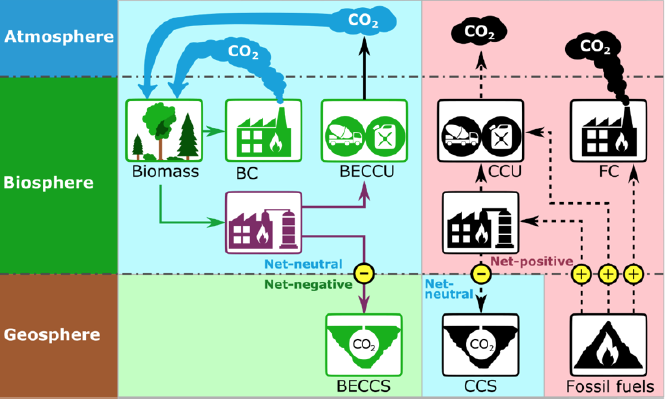BECCUS value chains – from concept to commercialization
Deployment of BECCUS value chains – Download
In the past few years, a consortium of IEA Bioenergy Tasks – Task 36, Task 40, Task 44 and Task 45 – collaborated in a project called Deployment of BECCUS value chains. The objective of the project was to improve the understanding of the opportunities for, and obstacles to, deployment of bioenergy combined with carbon capture and utilization or permanent storage (BECCUS).
The ambition of the project was to cut across a broad set of factors that together determine successful deployment. This has included analysis of techno-economic fundamentals and technology readiness, but also business model viability as well as design of appropriate policy and regulatory frameworks. Project components can be classified as belonging to one of two categories, with studies on the one hand looking into cross-industrial and conceptual aspects (system studies) and the on the other hand being industry case studies or deep-dives. All in all, seven publications have been produced as project outputs. These can be found here.
This report includes a summary and a synthesis of these individual studies, as well as a discussion and an outlook into questions to be further explored in future research.
The project findings show that, while much of the technology necessary is proven to a great extent, more R&D is needed to find business models for on-the-ground deployment that make the most sense from a techno-economic standpoint when applying CCS (carbon capture and storage) and CCU (carbon capture and utilization) respectively. This includes aspects such as specific designs and technology selection (for example, for CO2 capture), deployment scales, and site location selection. Furthermore, there are still unanswered questions related to policy design and business models. While some of these issues are evaluated and discussed in this report, several additional questions have arisen during the project and need to be addressed.
Some particularly important aspects for further inquiry can be mentioned. To begin with, despite there being technologies for CO2 capture that are rather mature and that could be deployed in the near time without much further development, there are emerging approaches that can come with important advantages in the form of improved efficiency and lower costs. Another important conclusion from this project is that conditions for deployment of BECCS and BECCU will vary markedly between the different heavy industries of the secondary industrial sector and national contexts. Varying suitability of different CO2 capture technologies for existing bioenergy generation concepts is an example of one such condition. But these also include system-wide aspects such as how to integrate BECCUS into full supply chains. In terms of national context, the governance support for BECCS and BECCUS applications among different countries and regions is very heterogeneous. In some countries and regions first deployment activities with first implemented business models can be observed e.g., in the Scandinavian region. In other countries, on the contrary, there are still mainly research activities to address the question if BECCS and BECCU should be applied at all. Furthermore, although this report discusses BECCS and BECCU jointly and in parallel, there are large differences between the two concepts. These differences partly relate to how the two play fairly distinct roles in terms of climate change mitigation. This also spills over into how policy frameworks and business models are set up.
These emerging questions are presented and discussed in the conclusion section of this report. Moreover, many of these issues will be analyzed and discussed in more detail in a second phase of the project that will run from 2022 to 2024. Next to case studies covering further industries of the secondary industry sector, the core question when to utilize. Hence, the two projects combined will allow for a complete picture of technology options and a broader systemic view.

Figure: Schematic diagram of carbon dioxide cycles for CCS and CCU in bioenergy routes (left) and comparison with fossil routes (right)


